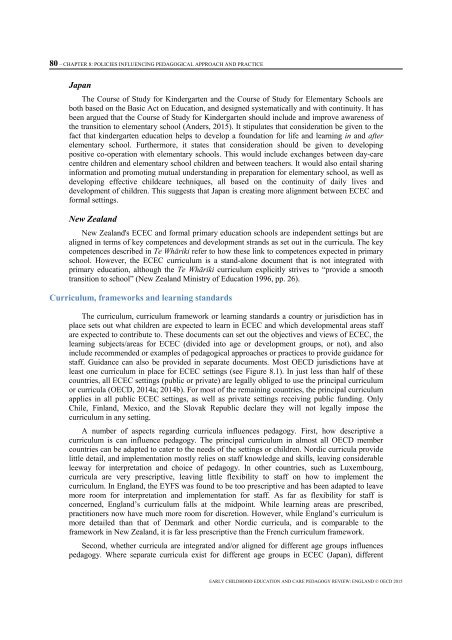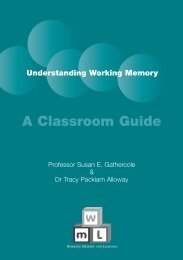early-childhood-education-and-care-pedagogy-review-england.pdf?utm_content=bufferb49b1&utm_medium=social&utm_source=twitter
early-childhood-education-and-care-pedagogy-review-england.pdf?utm_content=bufferb49b1&utm_medium=social&utm_source=twitter
early-childhood-education-and-care-pedagogy-review-england.pdf?utm_content=bufferb49b1&utm_medium=social&utm_source=twitter
You also want an ePaper? Increase the reach of your titles
YUMPU automatically turns print PDFs into web optimized ePapers that Google loves.
80 – CHAPTER 8: POLICIES INFLUENCING PEDAGOGICAL APPROACH AND PRACTICEJapanThe Course of Study for Kindergarten <strong>and</strong> the Course of Study for Elementary Schools areboth based on the Basic Act on Education, <strong>and</strong> designed systematically <strong>and</strong> with continuity. It hasbeen argued that the Course of Study for Kindergarten should include <strong>and</strong> improve awareness ofthe transition to elementary school (Anders, 2015). It stipulates that consideration be given to thefact that kindergarten <strong>education</strong> helps to develop a foundation for life <strong>and</strong> learning in <strong>and</strong> afterelementary school. Furthermore, it states that consideration should be given to developingpositive co-operation with elementary schools. This would include exchanges between day-<strong>care</strong>centre children <strong>and</strong> elementary school children <strong>and</strong> between teachers. It would also entail sharinginformation <strong>and</strong> promoting mutual underst<strong>and</strong>ing in preparation for elementary school, as well asdeveloping effective child<strong>care</strong> techniques, all based on the continuity of daily lives <strong>and</strong>development of children. This suggests that Japan is creating more alignment between ECEC <strong>and</strong>formal settings.New Zeal<strong>and</strong>New Zeal<strong>and</strong>'s ECEC <strong>and</strong> formal primary <strong>education</strong> schools are independent settings but arealigned in terms of key competences <strong>and</strong> development str<strong>and</strong>s as set out in the curricula. The keycompetences described in Te Whāriki refer to how these link to competences expected in primaryschool. However, the ECEC curriculum is a st<strong>and</strong>-alone document that is not integrated withprimary <strong>education</strong>, although the Te Whāriki curriculum explicitly strives to “provide a smoothtransition to school” (New Zeal<strong>and</strong> Ministry of Education 1996, pp. 26).Curriculum, frameworks <strong>and</strong> learning st<strong>and</strong>ardsThe curriculum, curriculum framework or learning st<strong>and</strong>ards a country or jurisdiction has inplace sets out what children are expected to learn in ECEC <strong>and</strong> which developmental areas staffare expected to contribute to. These documents can set out the objectives <strong>and</strong> views of ECEC, thelearning subjects/areas for ECEC (divided into age or development groups, or not), <strong>and</strong> alsoinclude recommended or examples of pedagogical approaches or practices to provide guidance forstaff. Guidance can also be provided in separate documents. Most OECD jurisdictions have atleast one curriculum in place for ECEC settings (see Figure 8.1). In just less than half of thesecountries, all ECEC settings (public or private) are legally obliged to use the principal curriculumor curricula (OECD, 2014a; 2014b). For most of the remaining countries, the principal curriculumapplies in all public ECEC settings, as well as private settings receiving public funding. OnlyChile, Finl<strong>and</strong>, Mexico, <strong>and</strong> the Slovak Republic declare they will not legally impose thecurriculum in any setting.A number of aspects regarding curricula influences <strong>pedagogy</strong>. First, how descriptive acurriculum is can influence <strong>pedagogy</strong>. The principal curriculum in almost all OECD membercountries can be adapted to cater to the needs of the settings or children. Nordic curricula providelittle detail, <strong>and</strong> implementation mostly relies on staff knowledge <strong>and</strong> skills, leaving considerableleeway for interpretation <strong>and</strong> choice of <strong>pedagogy</strong>. In other countries, such as Luxembourg,curricula are very prescriptive, leaving little flexibility to staff on how to implement thecurriculum. In Engl<strong>and</strong>, the EYFS was found to be too prescriptive <strong>and</strong> has been adapted to leavemore room for interpretation <strong>and</strong> implementation for staff. As far as flexibility for staff isconcerned, Engl<strong>and</strong>’s curriculum falls at the midpoint. While learning areas are prescribed,practitioners now have much more room for discretion. However, while Engl<strong>and</strong>’s curriculum ismore detailed than that of Denmark <strong>and</strong> other Nordic curricula, <strong>and</strong> is comparable to theframework in New Zeal<strong>and</strong>, it is far less prescriptive than the French curriculum framework.Second, whether curricula are integrated <strong>and</strong>/or aligned for different age groups influences<strong>pedagogy</strong>. Where separate curricula exist for different age groups in ECEC (Japan), differentEARLY CHILDHOOD EDUCATION AND CARE PEDAGOGY REVIEW: ENGLAND © OECD 2015



